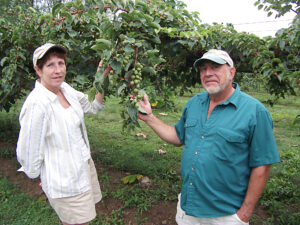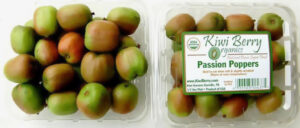Food Hubs: A Producer Guide
By Andy Pressman, NCAT Agriculture Specialist
Abstract
Small and medium-sized farms are often challenged with finding new markets that support their ability to increase production and that help meet increasing demands for fresh and locally raised food. Local and regional food hubs are improving market access for farmers and ranchers by operating aggregation, storage, processing, distribution, and marketing services for local producers. This publication focuses on providing producers with information, resources, and case studies specific to understanding how food hubs can provide new marketing outlets.
Introduction
Interest in local and regional food systems is increasing as their health benefits and contributions to economic, environmental, and social sustainability are recognized. Statistics from the United States Department of Agriculture (USDA) show growth in local food sales from about $4.8 billion in 2008 to $7 billion in 2011 (Low and Vogel, 2011). Traditional commodity markets continue to make up the vast majority of food distribution systems. They are structured around larger-scale mechanized production. However, new business and marketing opportunities for producers, many of whom are small and mid-size farms and ranches, are being created to enhance direct-to-consumer market outlets. Food hubs are playing a valuable role in local and regional food systems by providing small and mid-size farms and ranches with access to more mainstream and larger-volume markets through distribution support and other services.
The more than 200 food hubs currently in operation in the United States are helping to remove economic and infrastructural barriers in order to facilitate the supply of local food to larger markets. Supply chains traditionally move food from the farm to a packing and shipping facility or processor and then to a wholesale distributor. While this model once supported local businesses such as canneries, mills, grain elevators, and independently owned grocery stores, today’s system focuses on economies of scale, i.e., increases in efficiencies to produce larger volumes of product allow for a decrease in consumer price. As a result, smaller producers face challenges, such as in distribution and processing, which limit their ability to supply larger markets, including institutions, restaurants, retail stores, and other commercial markets.
Food hubs operate in many forms but all serve to facilitate the sale of fresh and local food from producers to consumer markets. This publication is designed for producers who have an interest in working with food hubs. It provides information on food hubs, followed by an overview of considerations and production-oriented topics important in working with a food hub. Although many food hubs also work with meats, dairy, grains, and other products, much of this publication focuses on the food hub mainstays of fresh fruits and vegetables. Case studies and a list of further resources are included.
Defining Food Hubs
The demand for local food in larger-scale markets has exposed production, economic, and logistical challenges standing between local food buyers and smaller-scale producers. Small farms having less than $250,000 in annual gross sales make up 91% of all farms in the United States (USDA-NASS, 2009). And while small farms provide over half of direct–to-consumer sales, through such outlets as farmers markets, on-farm sales, and community supported agriculture (CSA) programs, many smaller-scale producers have limited marketing opportunities. This is particularly true for mid-size producers who have annual gross sales between $50,000 and $250,000, as they frequently find themselves too large to rely solely on direct-to-consumer sales, yet too small to compete on price in larger-scale commodity markets (Diamond and Barham, 2012).
The USDA currently defines a regional food hub as “a business or organization that actively manages the aggregation, distribution and marketing of source-identified food products primarily from local and regional producers to strengthen their ability to satisfy wholesale, retail, and institutional demand” (Matson et al., 2013). This working definition focuses on increasing small and mid-size producer access to wholesale market outlets through aggregation and distribution. Other definitions focus on economic, environmental, and social values as they relate to the mission and services a food hub provides. These can include health and social services, community development, and education. For this reason, food hubs are sometimes referred to as “values based supply chains” (Feenstra et al., 2012). Food hubs also are defined by their functions, such as selling to businesses or institutions, consumers, or both. For a detailed evaluation of food hub definitions, see the publication Toward a More Expansive Understanding of Food Hubs, listed in the Further Resources section of this publication.
Increasing Market Access
Food hubs coordinate the aggregation of products from multiple producers. With the exclusion of Internet-based, or virtual, food hubs, they also provide the infrastructure for packing and shipping to markets large quantities that most small-scale producers find difficult to manage on their own. Unlike larger farms, whose large sales volumes allow them to produce and sell at lower cost, smaller-scale producers are often unable to meet market demand, in terms of volume and quality, or to get a price that exceeds the cost of production and marketing (Feenstra et al., 2012). By creating markets and managing the relationships between producers and buyers, food hubs work to negotiate a fair price return to the producers. In fact, many food hubs are able to pay the producer a higher price than they would receive if they were selling the same goods through a similar wholesale market; food hubs often pay the producer 60-80% of the price paid by the buyer (Barham et al., 2012).
Aggregation
Aggregation is a key function for food hubs. By consolidating goods from multiple producers, food hubs generate larger volumes to compete in larger markets. Aggregation can broaden product selection, which can be a convenience and economic benefit to buyers by reducing the number of transaction costs associated with purchasing goods. Aggregated products are typically marketed, branded, and distributed under a single label; however, some food hubs prefer to maintain the identity of individual farms (Day-Farnsworth et al., 2009). Risks associated with product quality, consistency, and traceability arise from the aggregation of goods, and these risks must be managed. This underscores the importance of implementing proper harvest and postharvest protocols as identified in this publication.
Structure
The structure of a food hub relates to the nature of the business, its tolerance for risk, and its financial status. Most food hubs are legally structured as privately held corporations—such as limited liability corporations (LLC), not-for-profit organizations, or consumer- or producer-owned cooperatives, or they are publicly held. Informal business structures also exist. Food hubs, however, tend to be defined more by their function and impact on the local community than by their legal structure (Barham et al., 2012).
Local Impacts
Regional food hubs strive to get local food into retail, institutional, and other commercial markets, in addition to establishing themselves and their products on social, environmental, and community-based values. Value-based supply chains, or food hubs, differ from traditional food distribution enterprises in this capacity. This can be seen by the fact that 40% of food hubs operate in designated food deserts (USDA, 2011). In addition, food hubs place value in working with producers who implement sustainable production practices and who are themselves concerned with their environmental footprint. According to the National Food Hub Collaboration, “Half the food hubs have recycling programs, 44% have composting programs, and 22% have energy-saving programs” (Barham et al., 2012).
Regional food hubs are also having a positive impact on local economies. The annual gross sales for a food hub average $1 million, with many showing double and triple annual sales growth (Barham et al., 2012). Food hubs are committed to purchasing from small and mid-size local farms, which not only helps keep farmers farming, but also influences the need for other agriculture-sector-related jobs. Food hubs themselves create jobs, with a national average of seven full-time positions and five part-time jobs supported by each hub (Barham et al., 2012).
Evaluating Food Hubs
As a producer interested in working with a food hub, it is important to evaluate several components of a hub to see if the operation meets your needs and the needs of your farm. Below is a list of factors to consider.
- Purpose/Mission – Food hubs target a particular customer base and are often oriented around a specific mission to help meet the economic, social, and environmental needs of a community. By looking at the purpose and mission of a food hub, a producer can determine whether or not the food hub is in line with the goals and values of the farm.
- Legal Structure – The legal business structure of a food hub influences how the food hub operates. Food hubs may be legally classified, for example, as a for-profit business, not-for-profit, or cooperative. Producers may be required to be involved in the operation or governance of the business and should be clear about what is expected of them.
- Types of Markets – Food hubs target specific types of markets that fit the purpose and infrastructure of the food hub. This includes larger wholesale markets as well as smaller retail outlets. The type of market plays a significant role in the products offered by the food hub.
- Products and Branding – Product selection and differentiation help ensure producers get a good price for their products. Food hubs utilize marketing strategies to differentiate products in order to help preserve the identity of the grower, their product(s), and their growing practices. When products are aggregated from different farms, it’s important to know whether the individual producer’s identity is preserved or whether aggregated products are branded under a single identity.
- Price – How is price determined? Is the price representative of any social, environmental, and community values? Is the food hub able to negotiate a price for products that don’t meet grading standards?
- Scale – Food hubs vary greatly in scale. Larger hubs typically work with more markets and in a wider geographical area than smaller food hubs. As a result, they tend to work with more producers and sell more types of products. Scale is important to consider in terms of variety selection, quantity, and price.
- Location – Where is the food hub located in relation to the producer? This is important to consider with regard to whether the producer has to deliver the product(s) to the food hub or the food hub provides on-farm pick-up services.
- Infrastructure – What type of infrastructure is available? Does the food hub have appropriately scaled equipment for processing, packing, storing, and distribution?
- Financing – How is the food hub able to operate financially? Does it have access to capital?
- Age – How long a food hub has been in business is important. Newer operations may not be as stable financially or in their daily operations as well-established food hubs.
- Contracts and Agreements – Does the food hub establish contracts with its producers and/or buyers to guarantee they will purchase from the producer at specified quantities, qualities, and price? What happens if the producer is unable to meet its obligation to the food hub?
- Logistical Support – What type of logistical support does the food hub provide? Do they offer assistance in crop planning? Do they furnish packing materials that are required?
- Insurance – Are there any specific types of insurance coverage required of the producer?
- Challenges – Food hubs face many challenges related to the viability of the business. As a producer working with a food hub, it is important to know what barriers the food hub is currently facing and how they impact the short- and long-term success of the food hub.
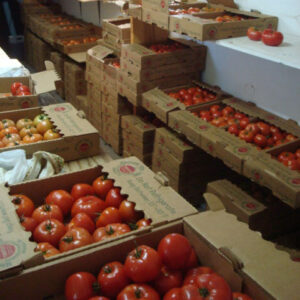
By working with growers on production planning, food hubs manage for consistent yields that meet the variety, grade, and packaging requirements for markets. Photo: Andy Pressman, NCAT
Production Planning
Food hubs can help agricultural producers achieve and maintain profitable businesses. A 2011 survey found that a food hub working with a median of 40 suppliers has the ability to increase producer profitability by enhancing access to commercial markets, purchasing seed, scheduling planting dates, and projecting sales for the season (Barham et al., 2012). As with any farm enterprise or marketing outlet, working with a food hub requires careful planning. This includes evaluating the relationship between working with a food hub and the goals established for the farm. It requires a careful examination of current on-farm resources, such as labor, equipment, and infrastructure, as well as what is needed in order to meet the needs of the food hub. Filtering the opportunity to work with a food hub through a farm’s mission statement and business plan will help determine whether or not the food hub is a good marketing outlet to pursue.
Costs of Production
Understanding costs of production can provide a basis for determining the success of a farm enterprise. Accurate record keeping and cost analysis will help determine whether producing a specific product is profitable and can help in determining labor, equipment , and infrastructure needs for selling that product to a food hub. Having accurate information on farm income and expenses will also help determine the price and revenue you will need in order to make a profit by selling through a food hub. It will also allow you to review whether or not it is cost effective to implement certain production practices that differentiate and add value to your products, such as being certified organic or GAP (Good Agricultural Practices) certified. Crop and livestock enterprise budgets are important decision-analysis tools useful for understanding costs of production and developing a whole-farm budget.
Working closely with producers is a defining characteristic of a food hub. Food hub operators not only manage the supply and demand of products between producers and buyers, but also play an important role in providing technical assistance and logistical support to their producers. By providing producers with information related to production costs, including processing, distribution, and marketing, food hubs better equip those producers to determine if a product will be profitable. This requires the producers to receive timely access to information, knowledge, and tools and materials they need to succeed. Sharing knowledge and coordinating planting dates, crop varieties, harvest dates, and quantities can result in access to higher quality and more competitive markets that deliver premium prices to the producer.
Crop Planning
Crop planning is an important component for producers in working with food hubs. In order for a food hub to manage an account, they expect a certain quantity at a specific date from a producer. From a crop-planning prospective, a producer needs to determine what crop(s) and/or variety to grow for a food hub, how much to grow, where it will be planted, and dates for starting seed and transplanting that correspond to each harvest date. Many food hubs work with producers and buyers prior to the growing season to coordinate production planning. This not only provides peace of mind for the producer in knowing that there is a market and acceptable price for their products; it also allows growers to cut costs by purchasing bulk seed, fertilizer, and other supplies together.
Crop planning starts with organizing the production within a single year. It relies on matching the cultural needs of crops to your farm soil types and climate and evaluating the frequency of succession plantings for a consistent supply. Using methods for extending the season and planting extra crops can help manage supply risks. Annual crop plans then become part of a long-term rotational plan for increasing soil fertility and yields.
Variety Selection
Once a food hub has established a market for a product, it will allocate the production among producers and determine how much each will supply. Although a buyer is primarily interested in a crop in general, it is important for the producer to pay attention to variety selection. A crop variety must not only be suitable for your farm’s soil and climate, but must also meet the specifications of the buyer, such as size, appearance, and shelf-life. The producer has the option of choosing a variety that will offer higher yields or disease resistance, as long as that choice doesn’t jeopardize either the buyer specifications or the farm’s bottom line. Evaluating varieties for better storability may also be critical in producing for a food hub, with the understanding that as a crop’s shelf life increases, quality, including taste and appearance, decreases.
Food Safety
Producers, food hubs, and buyers all have responsibilities in protecting both consumers and their own businesses from foodborne illness. While federal, state, and local regulations have historically focused on reactive procedures regarding foodborne illnesses, more recent legislation centers on the prevention of an outbreak. These measures require all farms, regardless of physical or financial size, to adhere to food safety practices that reduce the risk of a disease outbreak. Food safety risks from physical hazards, chemical hazards, and human pathogens all need to be managed during production and postharvest handling.
The Food Safety Modernization Act (FSMA) was passed and signed into law in January 2011. The Act gives food safety regulatory authority to the Food and Drug Administration (FDA), which is creating standards for growing, harvesting, packing, and holding produce, as well as rules for the operation of food-processing facilities. FSMA plays a critical role in the way growers who market to food hubs, and the hubs themselves, provide safe food to customers. Get more information about FSMA here.
Farm Food Safety Plans
A food safety plan is a written document describing practices and policies for operating safely and minimizing potential sources of foodborne illnesses. Food safety plans provide a layer of protection should an outbreak occur involving products from your farm. They document the steps followed to ensure safe production and food-handling practices. They are unique to each individual operation and should include the following:
- A risk assessment to identify areas of potential risk
- Standard Operating Procedures (SOPs)
- Records, logs, and certificates
- Policies for traceability and recall procedures
- Property information, maps, and soil and water test results
- Training logs and information
Get more information at the On-Farm Food Safety Project.
GAPs and GHPs
Good Agricultural Practices (GAPs) and Good Handling Practices (GHPs) are voluntary sets of standards established by the USDA. Through an audit process, GAP-certified farms and GHP-certified facilities for processing, storage, and distribution have proved that they utilize practices to minimize microbial food safety hazards in the production, handling, and storage of produce. Many institutional markets require growers and/or distribution facilities to be GAP or GHP certified or to be working towards GAP or GHP certification. The FDA has established guidelines for reducing microbial food safety hazards that serve as the foundation of GAPS and GHPs. To learn more, see the Guide to Minimize Microbial Food Safety Hazards for Fresh Fruits and Vegetables.
HACCP
Hazard Analysis Critical Control Points (HACCP) is a specialized system of food-safety control designed to prevent microbiological, chemical, and physical hazards from contaminating a product during production and distribution. HACCP is a proactive approach specific to food processing, utilizing principles to prevent contamination by identifying contamination channels, establishing control measures to eliminate or minimize food safety hazards, and monitoring the effectiveness of the program. By preventing contamination rather than testing for contamination after it may have occurred, the HACCP system can be a reliable and affordable risk management tool.
Organic Systems
In addition to federal, state, and local food-safety regulations, certified organic producers must also adhere to the rules and regulations of the National Organic Program (NOP). This includes maintaining an organic system plan (OSP) that details a farm’s practices for building soil fertility, increasing biodiversity, using approved sanitation practices and materials, and maintaining records. Many of the organic rules are formulated on the basis of HACCP, where critical control points (CCPs) are identified that can result in a loss of food safety. Unlike HACCP, however, the goal of organic standards is not solely to maintain food safety, but rather to protect the organic integrity of a product. Therefore, the NOP focuses on Organic Control Points (OCPs) rather than CCPs to identify instances where organic integrity can be lost. The loss of organic integrity is often related to contamination by sanitizers or cleaning agents, residues from previous nonorganic products, pesticides used in the processing or distribution facility, improper labeling, packaging, or storage, or from contamination during transport. Due to the requirements of the NOP and the documentation required for organic certification, certified organic producers already have in place much of the record-keeping “infrastructure” required for a food safety plan, including traceability.
Food Safety from Farm to Consumer
Food safety requires that everyone involved in the food system implement measures to reduce the risk of contamination, starting in the field and continuing until the food is properly prepared for the final consumer. Food-safety measures include the following (Kneen, 2011):
- Field and equipment sanitation
- Proper use (and disposal) of water
- Proper management and application of compost and manure
- Worker hygiene
- Harvest and postharvest facility sanitation
- Transportation vehicle sanitation
- Accurate record keeping and traceability
- Consumer education
Traceability
Wholesale markets, including food hubs, depend upon accurate records from their producers in order to trace a product quickly back to its source. The ability to identify the source is an essential part of food safety, and procedures and tools for traceback need to be developed for moving produce between the producers, distributors, and buyers. Documentation and labels should include the name and address of the farm, volume of product, and the lot number (date of harvest and field identification) for cartons. Recording who handled the product is also important for traceback.
Liability Insurance
Farmers and ranchers today face many risks associated with the production and sale of their products. Insurance coverage can protect against possible exposures that can damage an agricultural business. With several options available for producers and commercial agricultural businesses, policies can vary and be tailored to best meet the needs of the operation. Many producers carry a general farm liability insurance policy to protect against claims made for personal injury and property damages. General farm liability insurance provides coverage for employees as well as customers who are injured while on the farm premises or from farm operations. Similar types of liability insurance can also be applied to commercial businesses who engage in food processing, packaging, and distribution, such as food hubs. However, general liability policies typically do not protect against foodborne illness.
Food-product liability insurance protects against consumer claims of injury caused by a defective or hazardous product, such as a foodborne illness caused by contaminated fresh produce (Rejesus and Dunlap, 2009). A separate product-recall insurance policy can cover certain direct costs associated in a product recall. The federally subsidized crop insurance policies Adjusted Gross Revenue (AGR) and Adjusted Gross Revenue Lite (AGR-Lite) are whole-farm revenue products available in many counties that may cover some of the loss of profits or revenues due to a foodborne illness or product recall. For more information on AGR and AGR-Lite, see the ATTRA publication Crop Insurance Options for Specialty, Diversified, and Organic Farmers.
Harvest and Postharvest Handling
Food hubs and their associated buyers require the products they are purchasing from each producer to meet certain standards for production, harvest, and postharvest. Following protocols for harvesting and postharvest handling can assure a product meets specifications, in that its taste, nutritional quality, and appearance all are maintained throughout distribution and sale, and that food safety is protected during each step of the process. Smaller-scale producers and food hubs may be challenged in utilizing more appropriate technologies and practices for harvesting and postharvest handling as compared to larger-scale industrial operations. This is evident in examining the principal causes of postharvest losses and reduced quality of produce caused by improper handling, packing, and storage temperatures (Kitinoja and Kader, 2003). Many food hubs provide trainings to their producers on how to properly harvest, pack, store, and transport goods to the food hub in order to meet the requirements of the market.
Harvesting
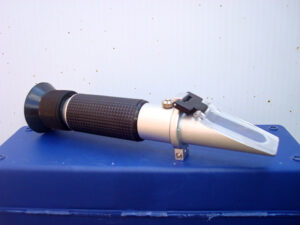
A refractometer can be used by growers to help
manage crop health. Photo: Andy Pressman, NCAT
Harvesting crops to meet the quality and quantity needs for a food hub requires producers to utilize processes and equipment to maximize efficiency and preserve crop quality. The timing of the harvest, both in terms of crop maturity and the time of day, the tools and techniques used to harvest, and how the harvested crops are removed from the field are important aspects to consider. Producers will have to determine if and when a crop is ready to harvest as it relates to the needs and expectations of the food hub. Maturity standards provide recommendations for specific crops as to when best to harvest a crop by evaluating its weight, flavor, storage, and nutritional quality. A refractometer is one tool that can be used in the field to measure the percentage of solids in a solution of juice taken from a crop. The degrees Brix can be observed, correlating the amount of sugars, vitamins, minerals, amino acids, proteins, hormones, and other solids to the sweetness and quality of the crop. Food hubs may have needs for some crops to be harvested before the crop reaches full maturity, as is the case with microgreens.
The time of day that a crop is harvested also affects crop quality. Crops such as leafy greens are more sensitive to heat and should be harvested early or late in the day, while fruiting crops, such as tomatoes and peppers, do better when harvested later in the day. This reduces the chances for disease, as well as making packing and storing convenient. Once harvested, all crops should be placed out of the sun and cooled to remove field heat. Pre-cooling, or cooling after harvest, protects the quality of the crop prior to postharvest handling.
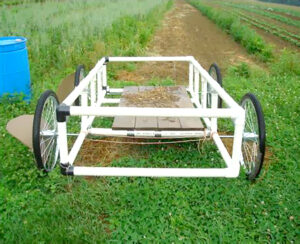
Photo: Andy Pressman, NCAT

Having appropriate harvesting containers and an efficient means of moving the containers to and from the field can help increase efficiencies and reduce damage after the crop is harvested. Baskets Photo: SPIN-Farming™
Efficiency in harvesting and moving the product from the field can be achieved by developing techniques that incorporate body ergonomics in relation to the tools and equipment used for each crop. While some larger-scale farms may use mechanized equipment for harvesting and field packing (and larger numbers of work crews), smaller farms depend on hand-power carts and some motorized equipment, including farm vehicles, for moving the harvested goods.
Having appropriate harvest containers can increase efficiency and prevent crop losses. The more a product is handled, the higher the likelihood of damage. Packing in the field at the time of harvest can reduce the number of times a product is handled. This involves selecting, sorting, preparing, and packaging crops in the field rather than at a postharvest station or at the food hub. Food hubs and their buyers require products to be packaged a certain way for delivery and distribution. Often, they will provide the producer with set guidelines for packing and may even provide the packaging to the producer. Whether packing at a facility or in the field, labeling is critical, especially to prevent certified organic crops from comingling with conventional crops.
Postharvest Handling
Once a product is harvested, it needs to go through processes to ensure its quality and storability during distribution and beyond. These include removing soil and trimming excess material, sizing and grading, curing, bunching and weighing, and packing. Although some of these processes can take place in the field, they are often performed at an on-farm facility or at the food hub.
| Cleaning Fruits and Vegetables | |
| Several variables determine if and when a fruit or vegetable should be cleaned. They include the type of fruit or vegetable, the type of contamination, and market preference. | |
| Washing Practice | Crops |
| Wash before cooling and packing | tomatoes, cucumbers, leafy greens |
| Wash after storage | sweet potatoes, potatoes, carrots |
| Dry brush (after curing or storage) | onions, garlic, kiwifruit |
| Do not wash | green beans, melons, cabbage, okra, peas, peppers, summer squash |
| Source: Kitinoja and Kader, 2003 | |
Temperature, humidity, and ventilation play important roles in all postharvest processes. Fruit and vegetable quality and storability can decrease as a result of such factors as respiration, transpiration, and exposure to ethylene. Respiration involves the production of water and the release of heat as well as a reduction in oxygen (Watkins and Nock, 2012). The loss of water through transpiration can affect a crop’s appearance and nutritional quality. The production of ethylene in plants serves as a growth regulator and is required for fruit ripening. Depending on the type of fruit or vegetable, exposure to increased levels of ethylene can cause premature ripening, yellowing of green vegetables, and even increased respiration rates. That said, ethylene can be added to non-organic fruits that are red in color to enhance color development.
Cold Storage

The CoolBot uses a micro-controller combined with a window-air conditioning unit to turn an insulated room into an energy-efficient walk-in cooler. Photo: Andy Pressman, NCAT
Working with food hubs requires the use of cold storage in order to minimize the deterioration of perishable goods from respiration, transpiration, ethylene, and spoilage. Pre-cooling removes the field heat from a crop prior to postharvest handling and is followed by cold storage to preserve the quality and safety of the product. In fact, buyers frequently require produce to be at proper storage temperature when it is delivered. Commercial refrigeration is often a limiting factor for small-scale producers; a significant function being provided by food hubs. On the other hand, on-farm cold storage can play a role in the amount and management of food being sold through a food hub. Managing the temperature, humidity, and ventilation in cold storage is important. Different crops store better at different temperatures and condensation levels and relative humidity can greatly affect crop quality if not managed properly.
There are several options for cold storage. The most appropriate method depends upon the size of the operation and type of product. There are several mechanical cold-storage options:
- Room cooling
- Forced-air cooling
- Hydro-cooling
- Top or liquid icing
- Vacuum cooling
Packaging
Food hubs and their customers may require that products be packaged in a certain way to protect and contain the crop during delivery and distribution, as well as to make the transport system economical and efficient. A food hub will often provide the producer with set guidelines for packing and may even provide the packaging. The food hub or customer may require individual standardized packaging, depending on a crop’s susceptibility to injury or damage, its temperature requirements, or its moisture content. For larger quantities, the use of a pallet system makes for uniformity and efficiency in packing and distribution and can protect products from additional handling and damage.
Labeling
Whether packing at a facility or in the field, labeling is critical. This is especially true for certified organic crops, in order to prevent comingling with conventional crops. As stated above, labels provide the necessary information needed to identify the source of a product, and they are an essential component of food safety. Labeling is also used for branding either through the food hub or as a means of maintaining individual farm identity. Adding a farm logo, slogan, and any certification logos that represent farm production practices, such as “USDA Organic” or “Certified Naturally Grown” can add value to the product. In addition, labels are used to help manage inventory. Price Look Up codes, or PLUs, can be used to manage inventory and track sales of bulk products. These four- or five-digit codes also provide convenience and efficiency in purchasing goods at store checkouts.
Case Studies
Red Tomato
Plainville, Massachusetts
Red Tomato is a not-for-profit regional food hub working to help connect small and mid-size wholesale farmers to better markets. Red Tomato distributes fresh fruits and vegetables to supermarkets located throughout the Mid-Atlantic and the Northeast. It works with more than 40 producers, many of whom are certified under the Red Tomato Eco label.
History
In 1996, Michael Rozyne, cofounder of the Fair Trade coffee company Equal Exchange, turned his attention to small and medium-sized farms located in the Northeast. Many of these farms were having trouble competing in an increasingly concentrated wholesale market. Rozyne wanted to take what he had learned in developing the Fair Trade principles of his coffee business and apply it to help area farmers gain access to new markets.
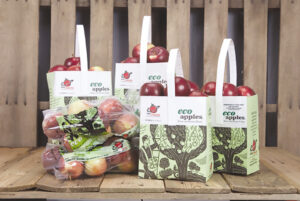
The Eco Apple label is used to brand apples sold by farmers following IPM protocols developed by Red Tomato. Photo: Red Tomato
For the first six years Red Tomato operated as a traditional distributer; working out of a warehouse and leasing trucks for distributing produce. However, the food wholesale industry was getting more concentrated and global in nature, which made it a challenge for Red Tomato to compete. It became apparent that under its initial operating model the organization was running into problems similar to those of the farmers they were trying to help. Precious time that was needed to brand local products, increase sales, and manage logistics was taken up with aggregation and delivery of the product. In 2001, a decision was made to change the model of the organization radically.
Red Tomato closed down its warehouse and trucking operations and began to concentrate efforts on marketing and logistics. Its marketing strategy started to focus more on branding and packaging to distinguish its fruits and vegetables as local and farm–identified. With this new model, existing on-farm infrastructure, in the form of packing houses, storage, and trucks, was used to aggregate and ship produce. Third-party trucking and storage companies were utilized to augment this system when needed. As a result, Red Tomato was able to focus on strengthening its supply chains, increase support and marketing for its farmers, and concentrate on differentiating its produce in order to help negotiate good prices. In 2005 Red Tomato began development of the Red Tomato Eco Apple label to better differentiate Northeast apples.
Mission
As a nonprofit, Red Tomato is positioned to compete in a competitive market, as well as operate as a mission-driven organization. The Red Tomato mission is “Connecting farmers and consumers through marketing, trade, and education, and through a passionate belief that a family-farm, locally-based, ecological, fair trade food system is the way to a better tomato” (Red Tomato, 2012). One way Red Tomato tries to fulfill this mission is by entering into “the dignity deal” with the farmer. This deal looks at three prices for each item being sold: average price from the previous year, the preferred price, and the lowest price the farmer can accept without taking a financial loss or losing dignity. Red Tomato then makes its best effort to sell at the preferred price and tries never to sell below the dignity price.
Its nonprofit status has allowed Red Tomato to pursue grant funding for innovative marketing projects such as the Eco label. Red Tomato also received funding to work with the Integrated Pest Management (IPM) Institute of America and agricultural scientists from Cornell University and the University of Massachusetts to develop protocols for a grower certification in advanced IPM practices. As a result, the team developed a system specific to the challenges faced by fruit growers in the northeastern United States. Farms are inspected the first year of certification and every three years thereafter, to ensure they are following the established Eco protocols. As of 2012, 22 farms produce fruit under these Eco protocols. While there are a few certified organic growers that sell through Red Tomato, the organic label is not a focus of the marketing strategy or branding. Instead Red Tomato has decided to focus on a broader brand position that includes regional farm identity, fair prices, and the internally developed Eco labels: Eco Apple™ and Eco Stone Fruit™. The principles of family-owned farms and farm worker safety are also incorporated into the brand, which further helps distinguish Red Tomato from other wholesalers.
Geographic Area
Red Tomato draws from producers throughout the Northeast region of the United States. Though most sales are to chain supermarkets in the Northeast, some of the produce it sells through distributers is sold in supermarkets as far south as Virginia and north to New Hampshire. This seems like a large region; however, according to Susan Futrell, Red Tomato’s marketing manager, Red Tomato is a small player in a large industry, and would need to get much larger before being too big is a concern. “In the context of competing in the wholesale produce market, we are on the small side and are always thinking about ways to scale up to give our farmers more options and the best prices. The challenge is to increase volume while maintaining local branding and short distances from farm to table” (Futrell, 2012). By working with farms in a large region of the country, Red Tomato has the ability to supply its customers more consistently through the entire growing season.
Red Tomato faces some challenges common to regional food hubs. Red Tomato doesn’t source product from outside the region, so matching supply with demand is an ongoing challenge. Also, related to this, severe weather can affect a crop and add to the complexity of sourcing a product. Futrell noted that this has been more of a factor in recent years (2012).
Relations with Producers
In addition to the many marketing benefits associated with selling through Red Tomato, farmers are invited to an annual meeting, hosted by Red Tomato, to review production protocol for Eco certification, hear reports from researchers, and discuss marketing strategies. Red Tomato also shares information throughout the season, in the form of feedback on product quality and customer response to products, with the farmers in order to improve marketing strategies.
There are more than 40 farms involved with selling their fruits and vegetables through Red Tomato. Each year Red Tomato surveys its most active growers; or those Red Tomato deals with most. In 2011, the range in size of the 24 farms surveyed was 10 to 650 acres. Annual farm sales on these farms ranged from under $250,000 to $5,000,000, with a median of 5% of sales off of each farm going through Red Tomato (Futrell, 2012).
The relationship between Red Tomato and the farmers who sell through it is collaborative in nature. Red Tomato looks for ecologically minded farmers who sell wholesale and are open and willing to work together on branding, packaging, and distribution. Other than the Eco label protocols for specific crops, there are no formal guidelines or contracts for farmers to sell through Red Tomato. Farmers trust that Red Tomato is fulfilling its promises under the dignity deal to fetch the best possible prices for their produce.
Tuscarora Organic Growers
Hustontown, Pennsylvania
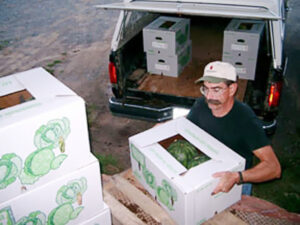
Eric Lichty of Shoestring Acres, a TOG member farmer, delivering melons to TOG’s loading dock. Photo: TOG
In 1988, three organic farmers in south-central Pennsylvania had the idea to organize their production and marketing efforts in order to supply customers in Washington, DC. With the recruitment of an additional four farms, they sold 1,500 cases of produce that first year. Several years later, this group formally became the Tuscarora Organic Growers (TOG), a member-owned food hub cooperative that continues to distribute organic produce throughout the capital area.
History
As explained by Jim Crawford, Board President and CEO of TOG and one of the initial seven growers, “The idea was sparked by the realization of how inefficient it was for smaller producers to sell to wholesalers” (Crawford, 2012). One common problem was not having enough of one item to secure an account with a wholesaler. Another was being recognized as organic but not getting paid a premium price for their produce. Because they could not always offer the quantities and consistency valued in a wholesale environment, these farmers had to be price takers in the wholesale arena. They could usually find a place to sell, but often at rock-bottom prices. Benefits from working together were immediately realized. The first farms involved started to share common markets and the responsibilities involved in getting their products to those markets. The simple act of sharing deliveries gave growers more time on their individual farms. Having more produce to offer also made it easier to approach new markets and ask for better prices.
There was little-to-no initial investment into the food hub. Only four components formed the basic infrastructure to start: a desk with a phone; a truck; a cooler; and a person to start managing sales and aggregation of the produce. In keeping with a goal of little or no capital investment into the hub, it found all four components at Jim and Moie Kimball Crawford’s New Morning Farm. At that time they had an office, a truck and cooler that weren’t being used to capacity, and a farm employee who agreed to work for the hub part time. A bank account was opened, and 30% of sales went directly into operating expenses.
Structure
Food hubs can be organized in many ways. From its inception, the farmers at TOG wanted it to be a farmer-owned cooperative. This means the farmers own the business and make all the decisions. The organizing farmers looked to other cooperatives in the region, such as Finger Lakes Organics in New York and Deep Roots Organic Co-op in Vermont, as models for their own cooperative. Farmers selling through TOG own part of the organization. Operational decisions are made democratically by all the farmer members who sell through TOG. This structure has worked well because growers who choose to sell through TOG appreciate what the co-op can do for them and they know what the co-op expects of them.
Relations with Producers
There are both member and non-member farmers who sell through TOG, with the difference being that non-members pay 10% to 15% of their sales to TOG. Crawford points out that it is not hard to become a member farmer. New members are often non-member farmers TOG has worked with in the past or farms recommended by a current member farmer. Farmers who are interested in selling through TOG are given a one-year trial period to see if it’s a good fit for them and for TOG. In addition, a consensus among the other member farmers is needed in order for a farmer to become a new member. Current members vote on possible new members at their annual meeting.
There are no contracts between the growers and the cooperative. Instead, everything is done on the understanding that a good-faith effort is being made by TOG and the member farmers to fulfill their obligations. Growers must trust that TOG is acting in their interest and will try to get the best possible price for them. Operating costs for TOG have come down since its start and now about 25% of income goes back into managing the food hub, while 75% returns to the farmers.
In addition to sharing the marketing and distribution burdens, TOG offers assistance to the farmers that sell through it in various ways. It organizes group purchasing of packaging boxes, seed potatoes, potting soil, and crop protection products like sprays and soil amendments. This allows bulk purchases of these items at a lower cost. TOG also holds educational meetings for its growers throughout the year, focusing on topics such as crop improvement, food safety, and season extension.
Marketing
TOG’s marketing strategy in the beginning focused on finding wholesale markets in the region that were interested in organic fruits and vegetables and were willing to pay a premium price. Restaurants and retail supermarkets who were already customers of some of the founding farms were approached and started buying from TOG. Many other markets were tested, but the markets had to correspond to the types and sizes of the farms involved. At first, TOG had a large variety of produce and not a large amount of any one item so it had to avoid large sales. According to Crawford, a co-op needs “to have a customer that will pay attention to (it). Scale differences don’t work” (Crawford, 2012). In other words, the size and scale of the buyer has to match the size and scale of the seller. Consequently, TOG went after a mix of customers who were small enough to pay attention to it and large enough to buy in volume.
In 2012, at least half of TOG’s close to $3 million in annual sales was to restaurants. TOG has found that of all the buyers it has approached, restaurants are the most profitable. Since restaurants tend to buy smaller amounts at one time, TOG’s pricing structure increases the produce price on smaller orders. The remainder of TOG’s sales is split between supermarket chains and food cooperatives, with a small amount sold to institutions throughout the Washington, DC, and Baltimore areas.
Challenges
Crawford identifies two drawbacks for farmers involved in selling through a regional food hub like TOG. First, growers can’t sell directly to TOG customers. This is a minor drawback for some larger producers who have enough products to supply two wholesale markets. Some TOG growers have tried to do this over the years, but it puts them in direct competition with their own cooperative. TOG strongly discourages its growers from doing this and the farmers seem to understand that this would not be a good practice. The second possible drawback is that growers have to adapt their production to the needs of the cooperative. This could be a barrier for established growers who are considering selling through a food hub like TOG, because they already have well-formed systems of production.
TOG has developed a very systematic approach to establish and meet market-driven production goals. A 1,200-line-item production plan is developed by TOG each year and is the heart of the cooperative. The plan is based on past sales and projected markets and identifies each item that will be needed, how much will be needed, and when. This is completed by March and then the items are divided up between the member growers. Each grower is assigned the crops they will grow for TOG for that season and the dates when those items will be needed. This is a streamlined way of managing the hard job of matching production to sales. It doesn’t leave the farmers with much say about what to grow for the co-op, but it helps to guarantee that most of what they grow will have a market. The assignment of which crops to grow corresponds with market needs and with the number of member growers. Many producers have been asked to grow the same types of vegetables for many years, allowing them to plan better for the upcoming season.
In addition to aligning production with market needs, another difficulty has been trying to span the winter season without having to turn away from member producers and buy from other suppliers. A decision was made by TOG early on to source as little product as possible from outside the region. In the early years, this meant shutting down in the winter for a few months because of the lack of product. Sometimes TOG turned to other regional hubs to bridge the gaps in its own product line. Over the years, as they have experimented with more season-extension techniques, TOG producers have become able to supply a substantial amount of product year-round.
Dave Jackson and Holly Laubach, owners of Kiwi Korners Farm, show off vines full of kiwi berries. Photo: Chris Lent, NCAT
A Voice in the Hub
Kiwi Korners, located in Danville, Pennsylvania, consists exclusively of more than 20 acres of hardy kiwi vines. Farmers David Jackson and Holly Laubach are the only certified organic hardy kiwi growers in the country who breed and pack their own varieties of this unique fruit. By working with regional food hubs, Kiwi Korners markets and distributes more than half of its kiwi berries to eastern markets. Jackson and Laubach use organic methods of production and measure for nutrient density in order to distinguish their fruit from fruit produced by their competitors in California. In addition, Jackson and Laubach created and were the first to use the term “kiwi berry” for these fruits and have since created the KiwiBerry Organics Company as a trade name.
Jackson and Laubach work closely with food hubs; selling 10 to 15%of their product through Tuscarora Organic Growers (TOG) in Pennsylvania and another 50 to 55%through Red Tomato in Massachusetts. The remainder is sold through other wholesalers, buying clubs, and direct markets. Jackson and Laubach also started a direct-to-consumer mailing business in 2011, called KiwiBerry Direct, where online orders are filled and shipped directly to the end consumer out of Kiwi Korners’ on-farm packing house.
The six-ounce container is filled with Passion Poppers, a hardy-kiwi variety developed at Kiwi Korners. Photo: Kiwi Korners
According to Jackson, more than 90% of the hardy kiwi fruit marketed in this country is picked before it is ripe and then treated with ethylene gas to speed the ripening process (2012). Not only does this process remove the fruit from the vine before it’s able to finish concentrating sugars and nutrients, but the accelerated ripening causes the fruit to go bad soon after the consumer takes it home. These practices have given hardy kiwi a bad name with some consumers and have kept the market from growing. By contrast, Kiwi Korners educates its consumers about the value of letting fruit ripen on the vine and about the perfect stage of ripeness for consuming it: kiwi berries aren’t perfect for eating until the skin loses a shiny look and starts to wrinkle slightly. In the wholesale produce industry, eye appeal of the product usually ranks above ripeness, taste, and nutritional content of the food. The opposite is true for food hubs like TOG and Red Tomato that work with farmers who differentiate their products on the basis of quality and who aren’t afraid to put words like “slightly wrinkled” on their packaging, as Kiwi Korners does to describe the best time to consume its fruit. To further differentiate its product, Kiwi Korners packages its kiwi in six-ounce plastic clamshell containers, rather than the four-ounce containers used by its competitors.
Western Montana Growers Cooperative
Arlee, Montana
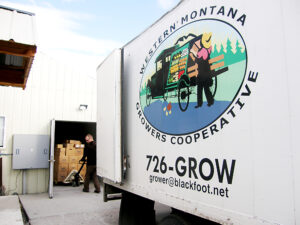
Caption: An employee of Lifeline Creamery in Victor, Montana, loads product into a WMGC delivery truck. Photo: WMGC
Started in 2003, the Western Montana Growers Cooperative (WMGC) aggregates, markets, and distributes fresh fruits, herbs, vegetables, dairy products, meats, and grains from 40 small and mid-scale sustainable farms to wholesale markets. WMGC also manages a multi-farm CSA that utilizes its central packing house, located in Arlee, Montana, and producer drop points to pick up and move the products to the facility. These drop points are located at member farms.
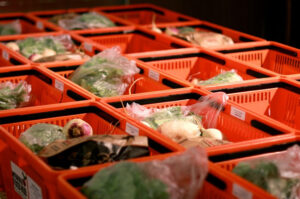
Aggregated produce ready for distribution. Photo: Interval Food Hub
WMGC has grown steadily despite the challenges of distributing food in Montana: having a small population base spread over a large area, as well as aggregating a list of products large enough to attract wholesale buyers. Contributing growers for WMGC cover a 200-mile corridor. WMGC is managing these challenges by increasing its distribution partners and by expanding its infrastructure. According to Dave Prather, WMGC’s General Manager, “the growth and success of WMGC is mainly attributable to the growers stepping up to produce more product” (Prather, 2012).
Kaly Hess and Brian Wirak started Harlequin Produce in 2009 and became WMGC member producers that same year. As beginning farmers, Hess and Wirak find selling through a food hub to be beneficial to the success of their farm. In addition to the marketing and distribution advantages gained through cooperative efforts, Hess says “there’s a tremendous opportunity to grow the crops we want to grow” (Hess, 2012). Based on previous years’ data, member producers at WMGC make informal commitments each year for what they will grow and how much they will grow. In this way, WMGC’s farmer members aren’t changing their production methods to be a part of the food hub, as may be the case with other food hubs.
Summary
Regional food hubs are helping small and midsize producers access new markets by managing the aggregation, distribution, and marketing of locally grown foods. They work closely with producers to guarantee that the producers get a good price for their products. By incorporating values into their business model, food hubs are having positive economic, social, and environmental impacts within their communities.
Further Resources
Articles
Increasing Farm Income and Local Food Access: A Case Study of Combined Storage, Marketing, and Distribution Strategies that Link Farmers to Markets. 2011. By Michele C. Schmidt, Jane M. Kolodinsky, Thomas P. DeSisto, and Faye C. Conte. Journal of Agriculture, Food Systems, and Community Development. Vol. 1, No. 4. p. 157–175.
An in-depth case study on the Intervale Food Hub in Vermont. Includes sections on collaborative marketing, development, farmer-led pricing, farmer needs, and advanced crop planning.
Toward a More Expansive Understanding of Food Hubs. 2011. By M. Horst, E. Ringstrom, S. Tymann, M.K. Ward, V. Werner, and B. Born. Journal of Agriculture, Food Systems, and Community Development. Vol. 2, No. 1. p. 209–225.
Article reviews the use of the term “food hub” and provides information for planning new food hubs and assessing existing sites. Includes case studies of three food hubs located in Seattle, Washington.
Publications
Building Successful Food Hubs: A Business Planning Guide for Aggregating and Processing Local Food in Illinois. 2012. Illinois Department of Commerce and Economic Opportunity, University of Illinois Business Innovation Services, Illinois Department of Agriculture, and FamilyFarmed.org. Oak Park, IL. 56 p.
This guide is aimed at those who want to plan and operate a regional food hub. It contains sections on aggregation, processing, and business development. It discusses where the producer fits into the picture of planning and launching a regional food hub.
Grower’s Manual: A Template for Grower Cooperatives. 2011. By Joanna Hamilton. Leopold Center for Sustainable Agriculture, Iowa State University, Ames, IA. 26 p.
This manual gives a good practical view of what procedures are necessary to meet GAP and GHP standards. Practical step-by-step procedures are listed, followed by pre- and post-harvesting instructions for individual vegetables.
Local and Regional Food Hubs Boost Economies. Rural Connections. 2012. By Betsy H. Newman (ed.). Western Rural Development Center, Logan, UT. 40 p.
Authors from throughout the country discuss innovative and tested approaches for food hubs that improve diets and the local economy at the same time.
Wholesale Success: A Farmer’s Guide to Food Safety, Selling, Postharvest Handling, and Packaging Produce, 3rd Edition. 2013. By Jim Slama and Atina Diffley (eds.). Oak Park, IL. 311 p.
This manual was developed to help farmers increase their capacity to meet the demand for locally and regionally grown fruits and vegetables. It includes sections on building relationships with buyers, calculating return on investments, and food safety. It also includes 103 crop profiles detailing specific information for harvesting, cooling, storage, and packing.
Websites
Farmers Markets and Local Food Marketing, USDA-Agricultural Marketing Service
USDA- Agricultural Marketing Service website for food hub information. Site contains articles, blog posts, newly released food hub research, and a working list of food hubs.
Fresh Fruit, Vegetable, Nut, and Specialty Crop Grade Standards, USDA-Agricultural Marketing Service
Lists USDA quality standards for fruits, vegetables, and nuts sold as commodities.
Know Your Farmer, Know Your Food (KYF2)
USDA
USDA initiative to strengthen the critical connection between farmers and consumers and support local and regional food systems. Website provides information, tools and resources, blogs, and funding opportunities related to strengthening local and regional food systems.
Food Hubs: A Producer Guide
By Andy Pressman and Chris Lent, NCAT Agriculture Specialists
July 2013
©NCAT
Slot 461
Version 073013
This publication is produced by the National Center for Appropriate Technology through the ATTRA Sustainable Agriculture program, under a cooperative agreement with USDA Rural Development. ATTRA.NCAT.ORG.
Related Publications
- Illustrated Guide to Growing Safe Produce on Your Farm: Good Agricultural Practices
- Scheduling Vegetable Plantings for Continuous Harvest
- Guide for Organic Processors
- Understanding Organic Pricing and Costs of Production
- Tips for Selling To: Produce Distributers
- Planning for Profit in Sustainable Farming

